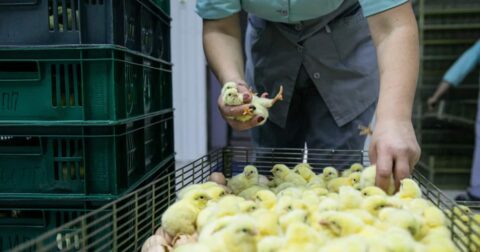Perspective
Critics Declared Veganism Dead in 2025. Here’s What Those Obituaries Are Missing.
Food•5 min read
Analysis
Animal advocates criticize the painful effects of rapid growth in chickens. But poultry producers often draw attention away from the issue, touting new innovations in their breeding methods and general welfare improvements. Is slower growth really better for birds?


Words by Jennifer Mishler
Farmed animal protection groups decry what they call painful physical effects of rapid growth in broiler chickens. But breeders and poultry producers often draw attention away from the issue, touting progress in their industries and advancements in selective breeding for faster-growing birds, leading to what they call “animal welfare improvements.”
We looked at both sides of the conversation to answer two simple questions: Is rapid growth a problem, and if it does present issues for birds, is slower growth better? It’s not as simple as it looks.
Investigative images and footage from inside broiler factory farms ruffle industry feathers, often revealing young birds barely able to stand or move, and some unable to survive long enough to be slaughtered at less than two months old. Crippled by the weight of their unnaturally heavy bodies, birds can become unable to reach water and food dispensers.
With 99.9 percent of chickens raised in factory farms, the industry has bred broiler birds to grow very large, very quickly so they can produce more meat at a lower cost. According to the Global Animal Partnership (GAP), 98 percent of commercially available chicken meat in the U.S. comes from fast-growing chicken breeds.
Many animal advocates emphasize that the lives of broiler chickens would be cut short regardless. Even if the birds grew slower, they would still be raised to suffer in a factory farm and killed a couple months later. But there is at least some indication that changing the way producers breed broiler chickens could be a step towards reducing their suffering.
A study by FAI Farms released in September found benefits for more slowly growing birds, including reduced mortality and increased engagement in enrichment and play behaviors. Lead researcher Annie Rayner stated, “A shift away from fast-growing breeds would provide the most significant improvement for the lives of the 142 million chickens produced in Europe every week.” Added Dr. Siobhan Mullan of Bristol Vet School, “This first independent commercial-scale trial provides robust evidence of the health and welfare benefits of slower-growing breeds of chicken.”
This question of just how important slower growth would be for broiler chickens is on the table at the Global Animal Partnership (GAP), which is considering changing the standards for slower growth in its Animal Welfare Certification Program.
In 2016, GAP announced that it will replace all fast-growing breeds with slower-growing chickens in all levels of its 5-Step Rating Program by the year 2024. To help inform the program’s changing welfare standards, GAP partnered with the University of Guelph on “the largest-ever study of broiler chicken health, welfare, and production,” which followed 7,500 birds from 16 genetic strains over two years.
Researchers found that “even under controlled conditions, with excellent management, fast-growing broiler chickens face significant animal welfare trade-offs such as less activity and poorer mobility, higher rates of muscle myopathies (e.g. woody breast, white striping), and potentially inadequate organ development,” according to GAP.
GAP currently certifies many big brands under its chicken standards, including Perdue and Applegate Farms. And it seems that the meat industry could be watching and bracing for the impact of this study.
In 2017 the National Chicken Council (NCC) released an industry-backed study finding that if one-third of the industry switched to slower-growing birds, it would carry a cost of about $9 billion and require raising almost 1.5 billion more birds to produce the same amount of meat. This also translated to a “tremendous increase in water, land, and fuel consumption,” according to the study’s authors.
But the question of whether this shift toward slower growth would benefit chicken welfare is not addressed in the findings.
“We don’t know if raising chickens slower than they are today would advance our progress on health and welfare—which is why NCC has expressed its support to the U.S. Poultry and Egg Association for research funding in this area,” said Dr. Ashley Peterson, NCC’s senior vice president of scientific and regulatory affairs.
Peterson acknowledged a “growing market” for slow-growth chickens, but added that “these improvements must be dictated by science and data—not activists’ emotional rhetoric—which is why we support further research on the topic of chicken welfare and growth rates.”
While the animal protection movement and the meat industry debate the merits of slow growth, the actual time difference and resources required are becoming clear.
The time difference is around two weeks. Birds considered slow-growing take about 14 more days to reach slaughter weight than those selectively bred for fast growth.
But if rapid growth leads to regular culling of birds who cannot survive until slaughter—as it so often does—why wouldn’t the industry choose the more sustainable alternative?
Most producers haven’t bought into the benefits of slower-growing chickens yet, but there are some exceptions. For example, Perdue offers meat from slower-growing chickens under its Petaluma Poultry line. Yet, other majors chicken sellers like Tyson are dragging their feet when it comes to reducing rapid growth in their supply chains.
These decisions are likely coming from the top, where Tyson and other titans of the poultry industry control each step of the process—from breeding to slaughter.
Still, it’s unclear how much longer rapid growth will fly, with many consumers growing increasingly concerned with farmed animal welfare, as well as transparency in the food industry, in recent years.